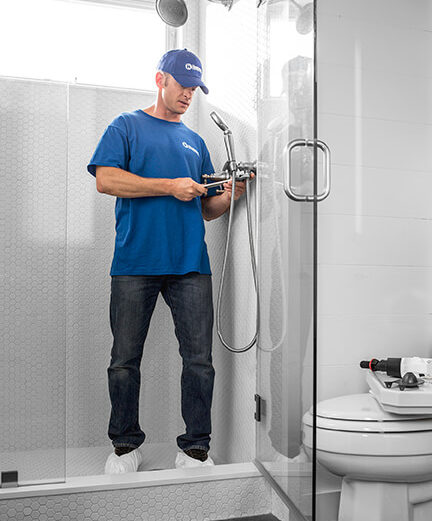We offer a wide range of services for that fresh look, or just maintenance or updates to keep your home functioning and safe. Regardless of the size of the job, we have a craftsman that can tackle it.

Home Improvement / August 30, 2015

The narrow stretch of wall located between your kitchen countertops and the upper cabinets offers you a wonderful opportunity to add a dash of decorative flair to the hard-working room. Tiling the area known as the backsplash makes it easier to clean up the spills and splashes that inevitably accompany kitchen activities too. Whether you take it on as a DIY project or let the pros at Handyman Connection of Carmel handle the job for you, a tiled backsplash can transform the look of your kitchen.
Getting Started: Choosing the Tile
From natural stone to porcelain, any tile that’s resistant to moisture can be used for a backsplash. You can choose a tile that matches your countertops for a seamless look or create an instant focal point with a contrasting style. While making sure that the tile complements your décor is important, it’s critical to consider functional factors too, including ease of installation. Large, heavy tiles may require covering your existing wall with a sturdy substrate.
The easiest tiles to install are those that come prearranged on 12-inch-square mesh-back sheets. Available in glass, ceramic, porcelain or natural stone, they come in every color imaginable in a range of artful patterns and designs. The mesh sheets save you from having to mount each tile individually, and they can be applied using pre-mixed adhesive and grout products, so you won’t have to mix a thinset mortar.
Tools You’ll Need for the Job
Whether you decide on a pre-mixed mastic or thinset mortar, you’ll need a notched trowel to spread the substance on the wall and a grout float to apply the grout. A variety of types of grout are available, so be sure to check the product’s label to make sure it’s compatible with your chosen tile. Pick up some latex caulk in the same color too, so you can seal the space where the backsplash meets the countertop.
The backsplash must be prepped before application, so you’ll need sponges and sandpaper as well. A tape measure, straight edge and level help ensure that that the tiles line up perfectly. Almost every backsplash tiling job requires cutting some tiles, so you’ll also need to rent or purchase a tile cutter. Tile nippers are helpful when you need to cut a curved shape.
Planning and Preparation
After measuring to establish the dimensions of your backsplash, lay out the pattern on a table or on the floor to ensure it will fit perfectly on the wall. After the backsplash area is thoroughly cleaned, dried and roughed up with sandpaper, measure and mark the center of the backsplash at counter level. Use your level to draw a vertical and horizontal line through the center mark.
Installation Tips
When applying the mastic or mortar, hold the trowel at a 45 degree angle and use a sweeping motion to cover a small area of the wall at a time. Work your way up and outwards from bottom center mark. Wait 24 hours or until the mortar is completely dry before applying the grout. Pack the grout deeply into the seams with the grout float, and then clean the surface with a sponge and clean water. Wait 30 minutes before you wipe the tiles clean with a dry cloth.
Unlike other kitchen improvements that require a substantial investment of time and money to complete, installing a backsplash is an affordable project you can finish over a weekend. If you’d like to skip the labor and just enjoy the results, schedule a free, no-obligation consultation with the craftsmen at Handyman Connection of Carmel. We’re here to help you make short work of your home improvement projects.